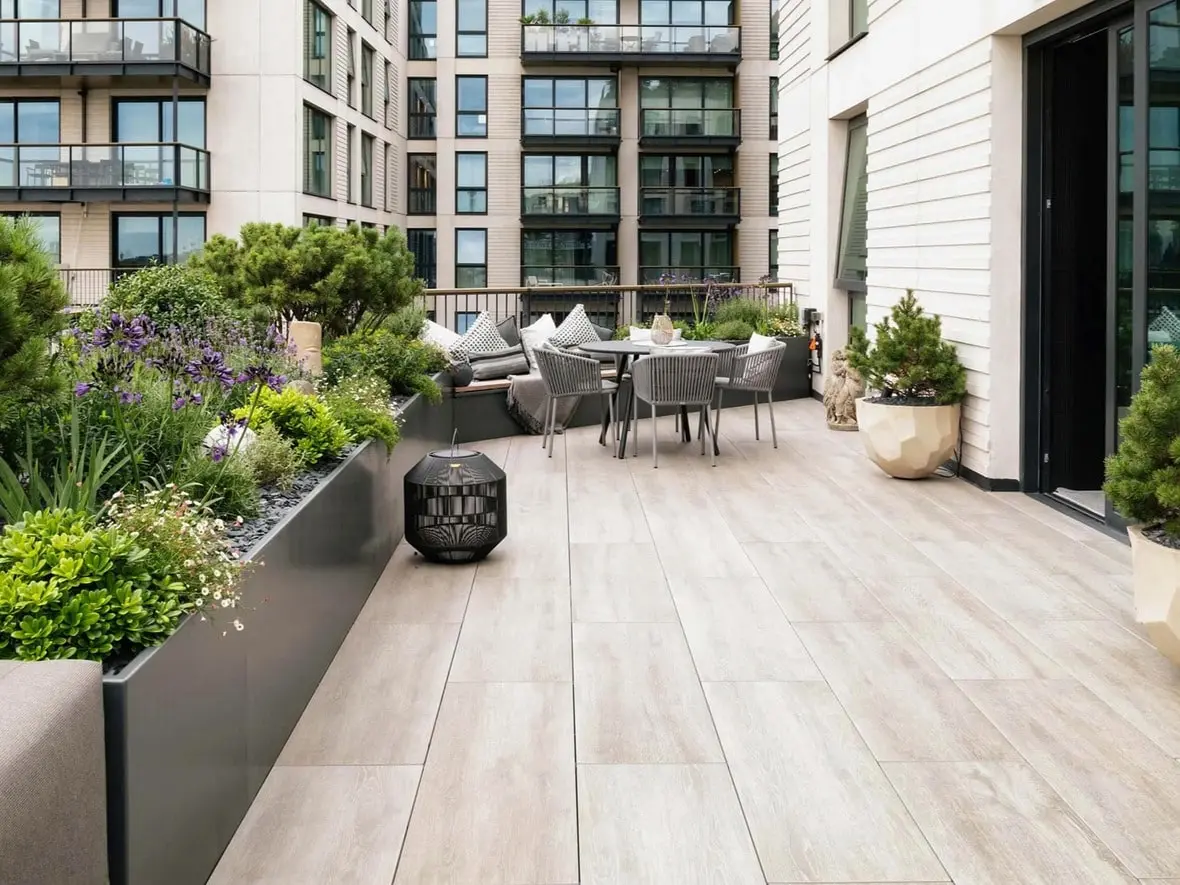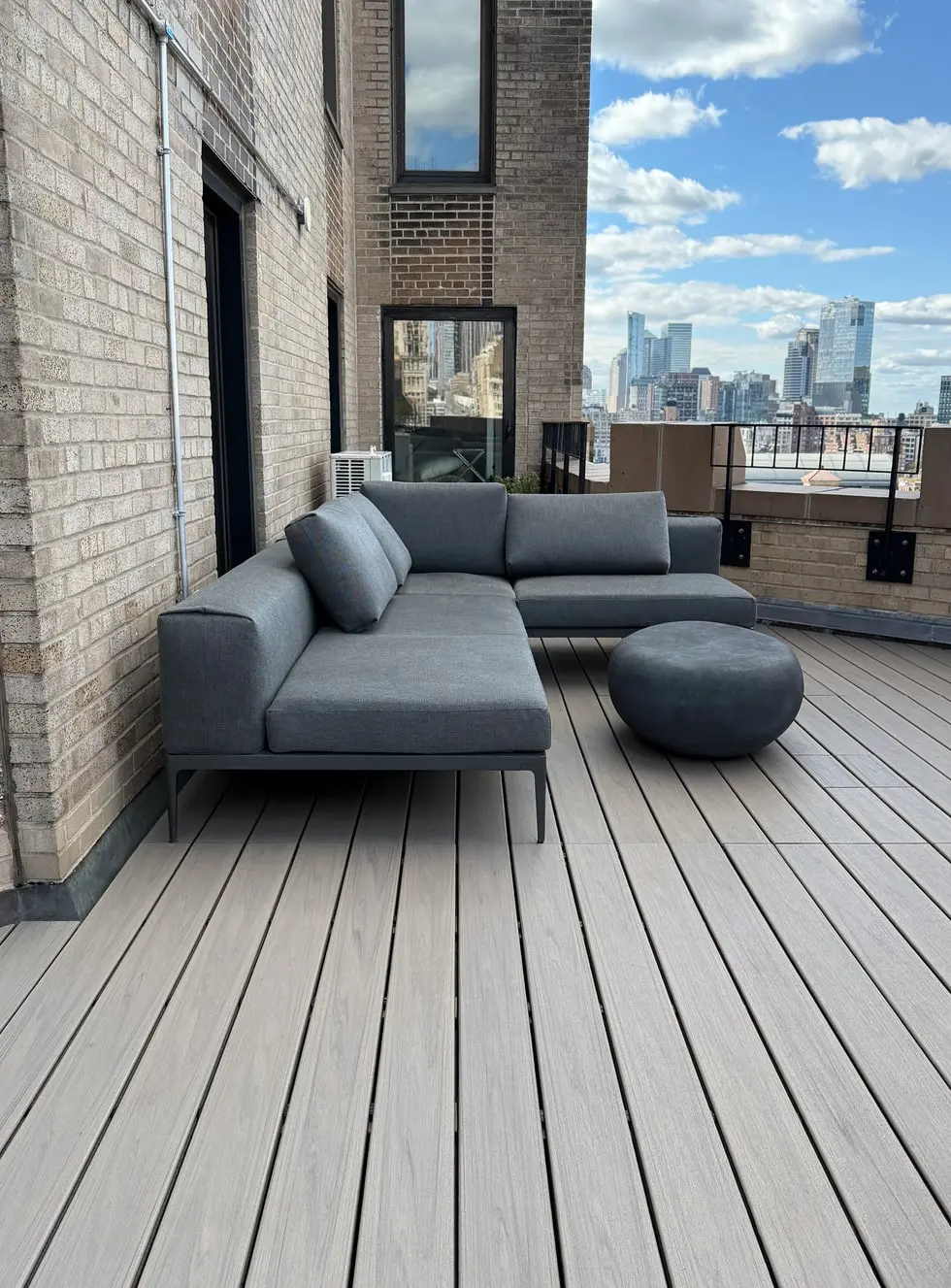What the NYC code says about combustible materials
According to Section 1509.5.3 of the 2022 NYC Building Code, combustible materials are allowed on rooftops only under certain conditions. Specifically:
“Combustible decking and rooftop pavers shall not cover more than 20 percent of the area of a roof, unless otherwise approved by the commissioner.”
That means wood decking, including hardwoods like ipe, can only be installed over up to 20% of the total roof surface unless the material meets specific exceptions or the project qualifies under grandfathered provisions (more on that below). In practice, this rule often limits full wood decking installations on new rooftop projects unless a non-combustible base or paver system is used.
Popular rooftop decking materials that comply with code
NYC’s fire and building codes heavily favor non-combustible or fire-rated materials. Some of the most commonly approved options include:
• Porcelain pavers (on pedestals): Durable, non-combustible, and fully compliant
• Concrete pavers: Heavier but widely used
• Fiberglass grating or aluminum decking: Lightweight and fire-resistant
• Fire-rated composite decking: TimberTech Advanced PVC Vintage® and Landmark® collections are an example of Class A Flame Spread Rating
Hardwood decking, while technically combustible, can still be used in some rooftop applications when compliant with the 20% rule—or when using specific materials approved by the NYC Department of Buildings or FDNY.
Is ipe decking allowed on NYC rooftops?
Ipe decking is one of the most sought-after materials for rooftop decks in New York City due to its durability, resistance to decay, and premium look. While ipe is a combustible material, certain ipe-based systems have been approved for rooftop use.
For example, TileTech offers a line of ironwood pavers (a branded ipe product) that has been tested and approved by the NYC Fire Department for rooftop use.
This includes:
• Class A fire-rated wood tiles
• Compatibility with pedestal systems
• Code-compliant documentation available upon request
These systems allow designers and contractors to achieve the look and feel of real hardwood while staying within code. This is especially valuable when building rooftop terraces in luxury buildings throughout Manhattan and Brooklyn.

What is grandfathering and how does it apply?
If your rooftop deck was built before the original code revision date (often referenced as the pre‑2014 code) or under earlier filings, it may be grandfathered under previous rules.
This means:
• The existing deck may remain legally, even if it exceeds the current 20% combustible coverage limit
• Alterations or repairs to the deck may still be allowed without full code compliance, depending on the scope
• Full rebuilds or new permits may trigger compliance with current code
In general, if you’re planning to resurface, repair, or upgrade an existing wood rooftop deck, you may be able to preserve the existing footprint and material use under NYC DOB’s grandfathering provisions. However, any structural changes, expansion, or new permit applications will likely require adherence to the latest standards.
Always consult with an architect or filing representative familiar with NYC DOB processes to evaluate whether your project qualifies for grandfathering.
Tips for homeowners and contractors
If you’re planning a rooftop deck project in NYC, here are some practical tips:
• Get clear on your rooftop’s total square footage before designing with combustible materials
• Work with fire-rated or tested products from reputable brands
• Document grandfathered conditions if working on an older rooftop deck
• For hardwoods like ipe or ironwood, ensure documentation and testing are available and submit them in your DOB filing
• Use pedestal systems with pavers to avoid compromising roof membranes and stay compliant
• Always consult a licensed structural engineer and architect familiar with NYC rooftop code, zoning, and DOB filing processes
At Vandeck Builders, we’ve helped clients navigate these complex code requirements and build stunning, code-compliant rooftop decks in neighborhoods across Brooklyn and Manhattan.
“Good rooftop design starts with good code knowledge—choose materials that are as compliant as they are beautiful.”
Conclusion
While combustible materials like hardwood decking can still be used on NYC rooftops, the key is knowing the limits and exceptions. With the right materials, code‑aware design, and professional filing support, you can create a rooftop deck that is both beautiful and fully compliant.






-2.svg)